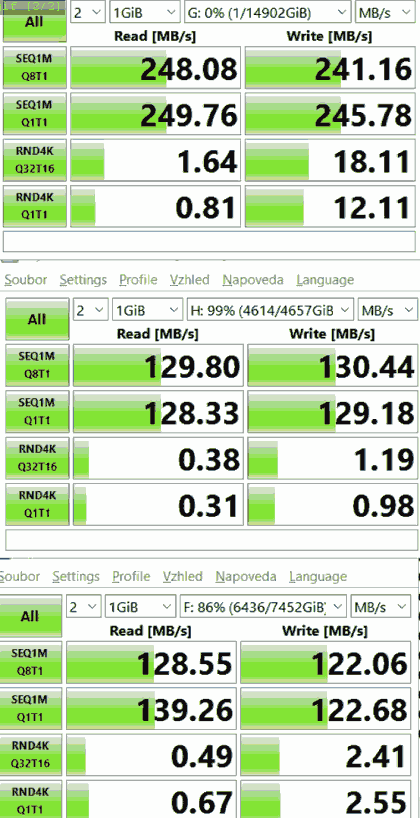postcd
Weaksauce
- Joined
- Nov 24, 2016
- Messages
- 96
Hello,
Hello, can anyone please comment on the comparison of the HDD Seagate Exos X16 16TB ST16000NM001G-2KK103 results between SATAII, USB 2 and USB 3?
from left to right: SATAII, USB2, USB3

The drive should have not been utilized by any other process and was empty during the tests.
In short, i am curious about 4K random operations differences between the interfaces. Differences seems to be significant.. The Q1T1 (Q=queued,T=transactions) is the same for USB2 and USB 3, yet the multithreading 4K (Q32T16) is way different. Why is it so? Is the 3.68MB/s maximum bandwith at Q32T16 for the USB2.0 interface or the interface has some strange limitation for threaded operations when comparing to single thread?
Here i am comparing this drive performance with WD Elements 5TB and 8TB drives. All via USB 3. You can see this drive is a performing significantly better than older drives:

Hello, can anyone please comment on the comparison of the HDD Seagate Exos X16 16TB ST16000NM001G-2KK103 results between SATAII, USB 2 and USB 3?
from left to right: SATAII, USB2, USB3

The drive should have not been utilized by any other process and was empty during the tests.
In short, i am curious about 4K random operations differences between the interfaces. Differences seems to be significant.. The Q1T1 (Q=queued,T=transactions) is the same for USB2 and USB 3, yet the multithreading 4K (Q32T16) is way different. Why is it so? Is the 3.68MB/s maximum bandwith at Q32T16 for the USB2.0 interface or the interface has some strange limitation for threaded operations when comparing to single thread?
Here i am comparing this drive performance with WD Elements 5TB and 8TB drives. All via USB 3. You can see this drive is a performing significantly better than older drives:

Last edited:
![[H]ard|Forum](/styles/hardforum/xenforo/logo_dark.png)